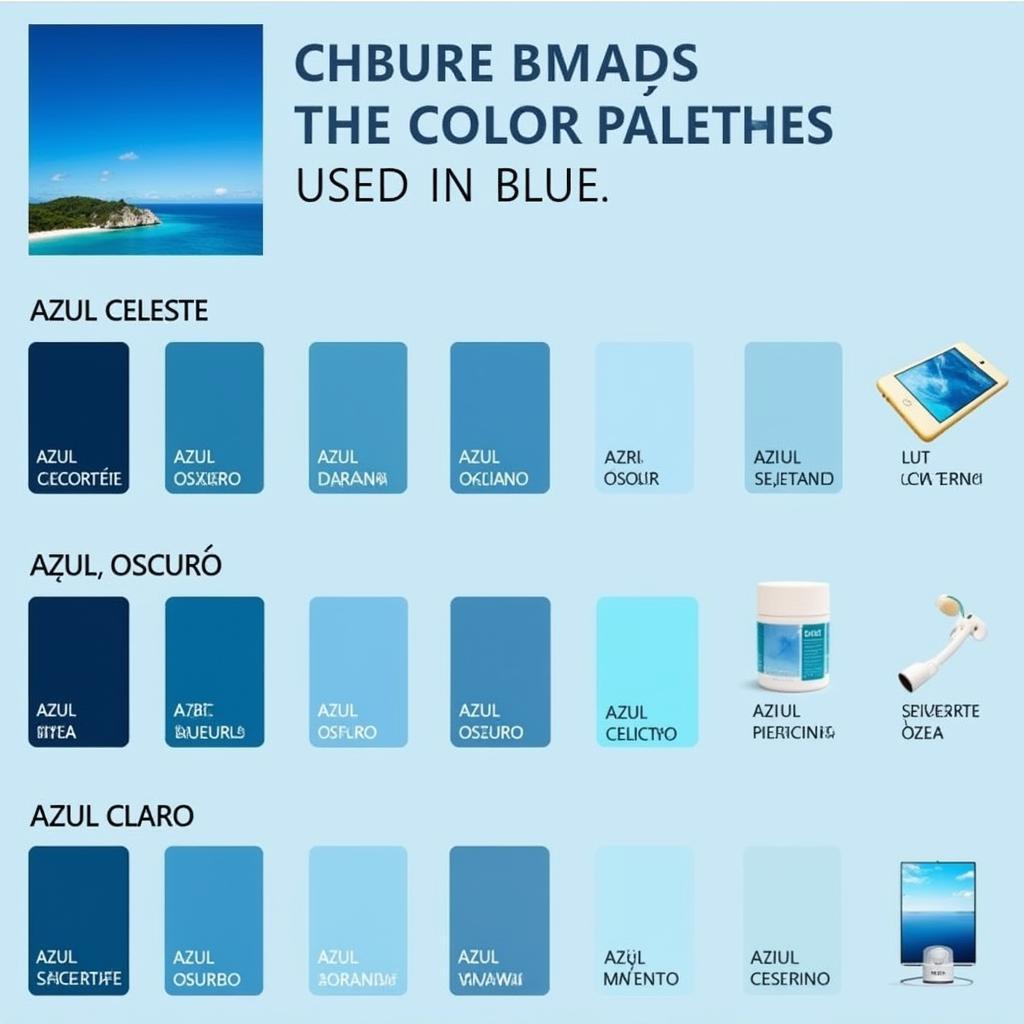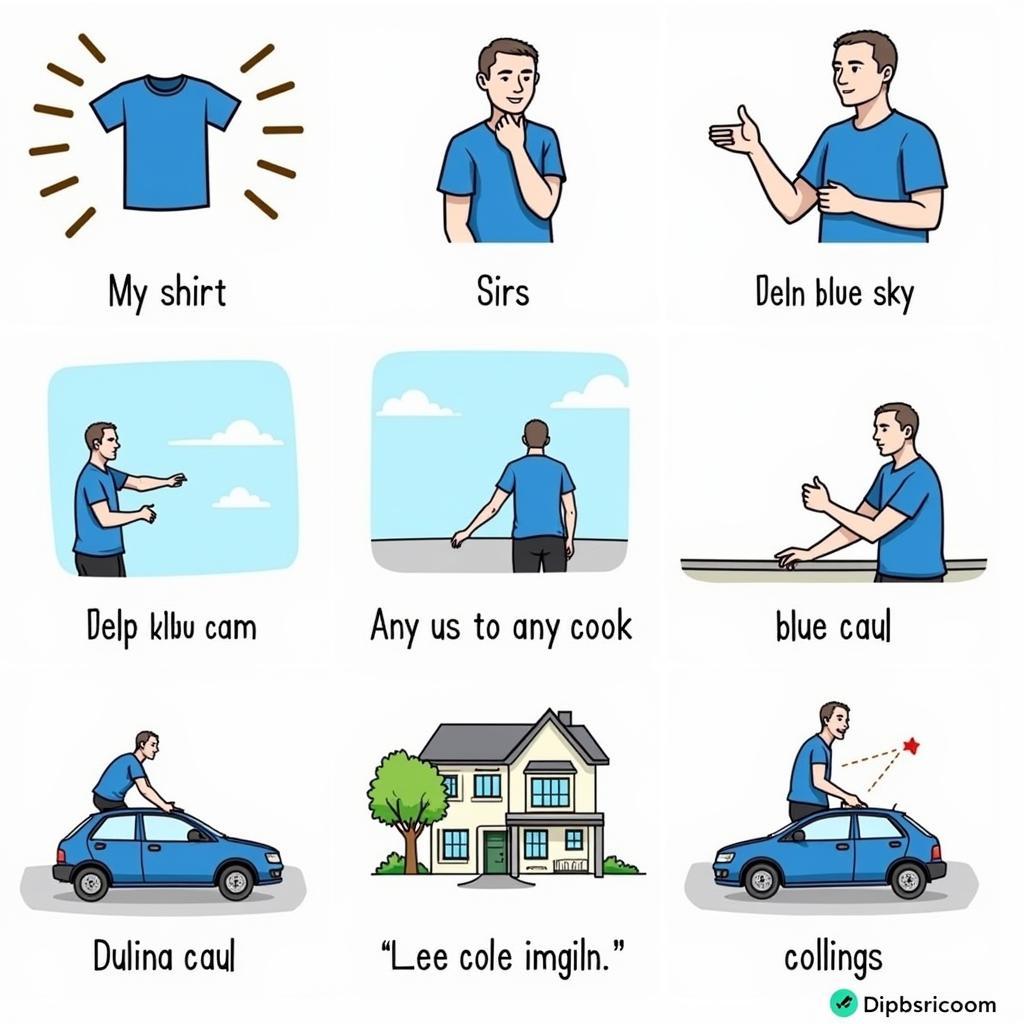Blue, a color often associated with tranquility and vastness, holds a special place in many cultures. But how do you express this captivating color in Spanish? The simple answer is “azul.” However, the world of blue in Spanish, like the color itself, is much richer than a single word.
Exploring the Shades of “Azul”
While “azul” is the most common and direct translation for blue, the Spanish language offers a vibrant spectrum of terms to describe its various shades and nuances. Just like English has sky blue, navy blue, or royal blue, Spanish boasts a diverse vocabulary to capture the subtle differences within the blue family.
- Azul Celeste: This term evokes the ethereal beauty of a clear sky, a lighter, brighter blue. Think of a cloudless day and the vibrant hue that stretches overhead.
- Azul Marino: For the deep, dark blue of the ocean depths, “azul marino” (marine blue) is the perfect descriptor. This rich shade is often associated with nautical themes and formal attire.
- Azul Oscuro: Simply meaning “dark blue,” this term covers a broader range of deeper blues, not specifically tied to the sea. It could describe anything from a midnight sky to a dark blue sweater.
- Azul Claro: On the opposite end of the spectrum, “azul claro” (light blue) describes softer, paler shades of blue, bringing to mind a gentle morning sky or a delicate watercolor wash.
Understanding these nuances can add depth and precision to your Spanish vocabulary, allowing you to paint a more vivid picture with your words. For instance, instead of simply saying “the car is blue,” you could say “the car is azul marino,” instantly conveying a more specific and evocative image. Just as understanding how to say my favorite color is blue in spanish allows for personalized expression, these nuanced terms enhance communication.
Beyond “Azul”: Other Blue-Related Words in Spanish
The richness of the Spanish language extends beyond simple color descriptors. Several other words incorporate the concept of blue, reflecting its cultural significance.
- Azulado/a: This adjective describes something that is bluish or tinged with blue, similar to the English word “bluish.” Imagine a gemstone with subtle blue undertones or a hazy mountain range in the distance.
- Azulón: Referring to a deep blue-black color, this word is less common but adds a touch of sophistication to your vocabulary. It might describe a rare bird’s plumage or a particularly striking shade of paint.
 Spanish Blue Color Palette: A Visual Guide to Different Shades of Azul
Spanish Blue Color Palette: A Visual Guide to Different Shades of Azul
Why is Knowing “Azul” Important?
Beyond basic communication, understanding the nuances of “azul” and its related terms can unlock a deeper appreciation for the Spanish language and culture. Color plays a significant role in art, literature, and everyday expression. By expanding your color vocabulary, you can connect with Spanish speakers on a more meaningful level. Just like knowing what does the venezuelan flag colors mean can provide cultural insights, understanding “azul” opens doors to a richer understanding of the Spanish-speaking world.
- Travel: Whether ordering a “coche azul” (blue car) or describing the “azul profundo” (deep blue) of the Mediterranean Sea, knowing the right words can enhance your travel experiences.
- Art and Literature: Appreciating the specific shades of blue used in Spanish paintings or described in literature adds another layer of understanding to these artistic expressions.
- Everyday Conversations: From discussing fashion choices to describing the weather, knowing “azul” and its variations allows for more precise and colorful communication.
 Everyday Use of "Azul" in Spanish: Examples of Common Scenarios
Everyday Use of "Azul" in Spanish: Examples of Common Scenarios
How do you say “My Favorite Color is Blue” in Spanish?
A simple and common way to express this sentiment is: “Mi color favorito es azul.” This translates directly to “My favorite color is blue.” You can also use more specific variations of “azul” to express your preference for a particular shade.
Maria Sanchez, a renowned linguist, emphasizes the importance of precise language: “Using specific shades like ‘azul celeste’ or ‘azul marino’ not only showcases your vocabulary but also expresses your personal taste with more accuracy.”
Conclusion
From the serene “azul celeste” of the sky to the profound “azul marino” of the ocean, the Spanish language offers a diverse palette of blues waiting to be explored. Knowing “azul” and its variations unlocks a deeper understanding of the Spanish-speaking world, enhancing communication and cultural appreciation. Remember, language is more than just words; it’s a window into a culture’s soul. Now that you know what color is fawn grey, you can explore further color nuances in both Spanish and English.
FAQ
-
What is the most common Spanish word for blue?
- Azul
-
How do you say light blue in Spanish?
- Azul claro
-
What does “azul marino” mean?
- Marine blue or dark blue
-
How do I say “the sky is blue” in Spanish?
- El cielo es azul.
-
What are some other words related to blue in Spanish?
- Azulado/a, azulón
-
How do you say “My favorite color is light blue” in Spanish?
- Mi color favorito es azul claro.
-
Where can I learn more about Spanish colors?
- Online resources, Spanish language textbooks, and immersive language experiences can all provide further knowledge. Consider exploring resources like what color blood do octopus have to expand your color knowledge in other contexts.
Need assistance with your color choices or home design? Contact us at Phone Number: 0373298888, Email: [email protected], or visit us at 86 Cau Giay, Hanoi. Our 24/7 customer service team is ready to help. Explore the vibrant world of colors further with de colores spanish song lyrics, and let the hues inspire your creativity.